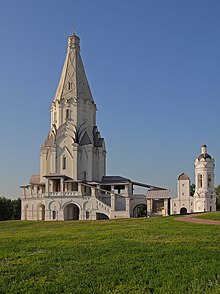Kolomenskoye
You can help expand this article with text translated from the corresponding article in Russian. (January 2023) Click [show] for important translation instructions.
|
| UNESCO World Heritage Site | |
|---|---|
 Ascension Church (1535) | |
| Location | Moscow, Russia |
| Criteria | Cultural: ii |
| Reference | 634 |
| Inscription | 1994 (18th Session) |
| Website | Official site |
| Coordinates | 55°40′10″N 37°40′08″E / 55.66944°N 37.66889°E |




Kolomenskoye (
The White Column of Kolomenskoye
Kolomenskoye village was first mentioned in the
The church reaches toward the sky from a low cross-shaped podklet (ground floor), followed by a prolonged chetverik (octagonal body, and then an octagonal tent, crowned by a tiny dome. The narrow
The great palace and other structures
Detailed plans of the Alexis I palace survived. The Moscow Government completed a full-scale reconstruction in 2010. The rebuilt palace stands approximately 1 kilometer (0.62 mi) to the south of its original location near the White Column, in order to preserve the historic foundations. The palace erected by Catherine the Great in 1768 was demolished in 1872, and only a few gates and outside buildings remain.


During the early Soviet period, under the initiative of architect and restorer Pyotr Baranovsky, old wooden buildings and various artifacts were transported to Kolomenskoye from different parts of the USSR for preservation, so currently Kolomenskoye Park hosts an impressive set of different constructions and historical objects.
Local buildings
- Church of John the Baptist in Dyakovo, 16th century. The church stands on the Dyakovo hill, located southwest from the Kolomenskoye hill. The church has five tent-like structures, and was probably constructed around 1547, reputedly by architect Postnik Yakovlev, the author of Saint Basil's Cathedral on the Red Square.
- Church of St. George, 16th century
- Standalone belltowerfor the church of St. George, 16th century
- Standalone refectory for the church of St. George, 16th century
- Church of Our Lady of Kazan, 17th century
- Watertower, 17th century
- Front gates, 1671–73
- Polkovhichyi chambers, 17th century
- Prikaznye chambers, 17th century
- Sytny yard, 17th century
- Back gates, 17th century
- Park pavilion, 1825
- Park gates, 19th century
Constructions and artifacts brought from elsewhere
- Barbican church of the Nikolo-Korelsky Monastery
- Bratsk Stockade Tower
- Boris stone from Belarus
- Polovtsianburial mound
- Chasovoy pole, 17th century
- Tower from the Sumskoy Ostrog fortress, 17th century
- Memorial pole from Shaydorovo village, 19th century
- Mead making facility, 18th century
- Peter the Great house (18th century) from the Northern Dvina
- Lion's Gates from the Moscow Kremlin(surviving fragments)
Reconstructions
- Water mill on the Zhuzha River
Natural features
- Oak-trees grove (one of the oldest oaks in Moscow)
- Golosov Ravine with sacred stones and springs in it
- Streams:
- Zhuzha River, emerging from underground
- Kolomenskoye Stream, in Golosov Ravine
- Kolutushkin Stream, in the ravine of that name
- Dyakovskaya Stream, in the ravine of that name, into which several other ravines empty (all on the left: Vospenkov, Lekseev, Bazarihin, Radyushin)
Archeological sites
See also
- Tsaritsyno Park
- Kuskovo
- Arkhangelskoye Estate
- Open-air museum
References
- Dixon, Simon. Catherine the Great (Profiles in Power). Harlow, UK: Longman, 2001 (paperback, ISBN 0-582-09803-3).


